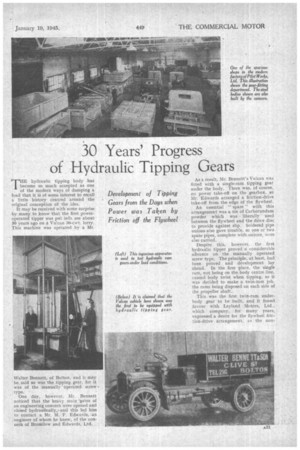30 Years' Progress
Page 33

Page 34

If you've noticed an error in this article please click here to report it so we can fix it.
of Hydraulic Tipping Gears Development of Tipping Gears from the Days when Power was Taken by Friction off the Flywheel THE hydraulic tipping body has become so much accepted as one of the modern ways of dumping a toad that it is of some interest to recall a little history centred around the original conception of the idea.
It may be received with some surprise by many to know that the first poweroperated tipper was put into use about 30 years ago on a Vulcan 30-cwt. lorry.
This machine operated by a Mr. was Walter Bennett, of Bolton, and it may be said so was the tipping gear, for it was of the manually • operated screw type.
One day, however, Mr. Bennett noticed that the heavy main gates of an engineering concern were opened and closed hydraulically,, and this led him to contact a Mr. M. F. Edwards, an engineer of whom he knew, of the concern of Bromilow and Edwards, Ltd. .
As a result, Mr. Bennett 'h Vulcan was fitted with a single-ram tipping gear under the body. There was, of course, no power take-off on the gearbox, so Mr. Edwards arranged a friction-drive take-off from the edge of the flywheel.
An essential " spare " with this arrangement was a tin of Carborundum powder which was liberally used between the flywheel and the drive disc to provide against slip. Soldered pipe unions also gave trouble, so one or two spare pipes, complete with unions, were also carried.
Despite this, however, the first hydraulic tipper proved a considerable advance on the manually operated screw type. The principle, at least, had been proved and development lay ahead. In the first place, the single ram, not being on the body centre line, caused body twist when tipping, so it was decided to make a twin-ram job, the rams being disposed on each side of the propeller shaft.
This was the 'first twin-ram underbody gear to be built, and it found favour with Leyland Motors, Ltd., which company, for many years, expressed a desire for the flywheel friction-drive arrangement, as the non
positive drive provided a margin of safety when tipping. The equivalent of this, in modern versions of power-driven . tipping gears, is found in the pressurerelease valve incorporated in the oil system,
Following the foregoing development, Mr. Edwards devoted his attention to what We now term the three-way tipper, and a model of his gear was shown at that time on the stand of Leyland Motors, Ltd., at the Commercial Motor Show.
Mr. Edwards and his seven brothers :oncentrated for many years on the production of these power-driven tipping gears until, in 1927, fonr of the brothers left Brorailow and Edward,, Ltd., to set tip the firm of Messrs. Edwards Brothers, of Bolton.
In November, 1937, Mr. Miles Edwards, with his two soons, Miles and Harold, started tip another company in Bolton and traded as Messrs. Miles Edwards.a.nd Sons. In order to avoid any confusion with previous interests, the title of the undertaking was later altered to Pilot Works, Ltd„ under which it is known to-day.
A modern works was built on the Manchester road, Bolton, and, with many of his former employees with 'hit* Mr. Miles Edwards, Senr.,. put several improved types of tipping gear on to the market under the trade mark "Pilot."
Some time later the other Edwards brothers sold their interests in Bromilow and Edwards, Ltd., and Messrs. Edwards Bros. and retired from the tipping-gear business.
Whilst it is not possible to give any detailed information concerning the war-time activities of Pilot Works, Ltd„ we believe that the number of tipping gears and steel bodies supplied to one well-known vehicle manufacturer exceeds four *figures. Several hundred coachbuilt cabs and wooden bodies
have also been supplied to Foster and Seddon, Ltd., of Salford, for its 6-ton oiler.
It may not be generally recognized that tipping gears have materially assisted in expediting the work involved in the building of war factories and airfields throughout the British Isles, for, without their aid, not only would vital time have been wasted, but a far greater number of men would have been needed at all unloading points.




















































